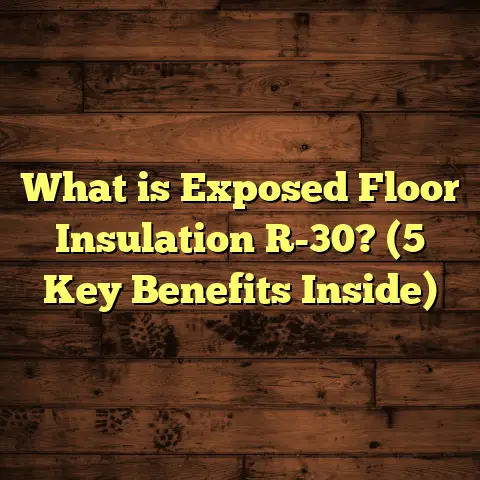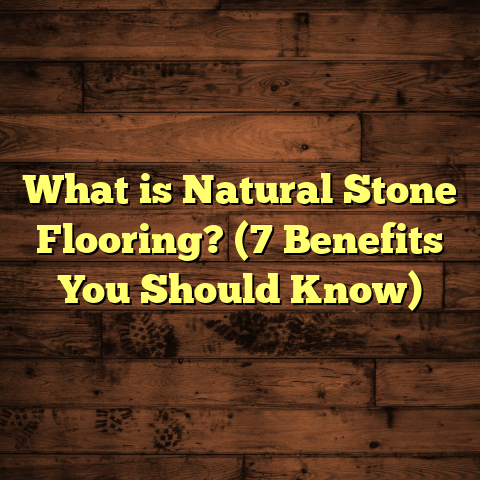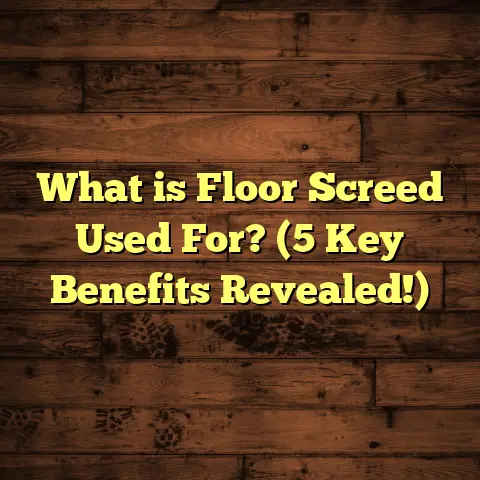What is Waterproof SPC Flooring? (5 Key Benefits Revealed)
Regional Needs Shape Flooring Choices
You know, where I live, the weather swings from humid summers to chilly winters, and the rainy season can get pretty intense. I’ve worked on homes in coastal areas where salt air and moisture make regular flooring materials swell and warp. If you’re in a region that sees a lot of rain, flooding, or humidity, you probably get what I mean—flooring that can’t handle moisture just doesn’t cut it.
Over the years, I’ve had clients from so many different places with similar challenges. For example, in parts of Florida where hurricanes are common, or the Pacific Northwest with its constant drizzle, homeowners want floors that won’t give up after a single spill or storm water intrusion. I’ve seen hardwood floors buckle and laminate peel off because they weren’t made for those conditions.
That’s why when I talk about Waterproof SPC flooring, I’m not just sharing some trendy product. This is a material designed with those exact problems in mind. It’s built tough, water-resistant, and surprisingly versatile. For anyone living in regions where moisture is a constant issue—and even those who just want a low-maintenance floor—SPC floors are game-changers.
What Exactly Is Waterproof SPC Flooring?
Let me break it down simply since SPC isn’t the most common acronym outside flooring pros.
SPC stands for Stone Plastic Composite. It’s a type of rigid vinyl flooring that combines limestone powder with PVC (polyvinyl chloride) to create a dense, hard core. Imagine mixing stone dust with plastic to get a solid yet lightweight base—that’s what SPC is at its heart.
This core makes SPC flooring super stable. Unlike traditional vinyl floors which can be soft and flexible, SPC holds its shape under heavy weight or impact. It doesn’t swell or warp when exposed to water because the core is 100% waterproof and non-porous.
The top layer of an SPC floor is usually a printed design film covered by a transparent wear layer. This wear layer protects against scratches, stains, and UV damage while showcasing realistic patterns—wood grain, stone textures, even ceramic tile looks.
I remember when I first installed SPC flooring for a client who was skeptical about vinyl products. The realism blew them away—the floor looked like natural oak hardwood but was way more resistant to their flood-prone basement’s moisture problem.
5 Key Benefits of Waterproof SPC Flooring
1. Truly Waterproof – No More Worrying About Spills or Floods
One of my earliest projects with SPC was for a family whose basement had flooded during a heavy storm. They had tried laminate before but ended up replacing it twice due to water damage. When I suggested SPC flooring, they were hesitant because of vinyl’s reputation for cheap looks.
After installation, months passed with no issues—even after another storm brought water into the basement again. The SPC floor stayed dry and intact.
Data backs this up too. According to the International Association of Certified Home Inspectors (InterNACHI), SPC flooring can withstand 72+ hours of standing water without damage. In contrast, engineered hardwood or laminate floors start absorbing water within minutes and can swell or delaminate within hours.
This waterproof property comes from the stone plastic composite’s tightly sealed core combined with the protective wear layer on top. Water sits on the surface but doesn’t seep through.
Action Tip: If you live somewhere with high humidity, frequent spills (like kitchens or bathrooms), or flood risk areas—SPC flooring is ideal because it prevents costly water damage repairs.
2. Durability That Stands Up to Heavy Use
If you’re like me, you want floors that won’t show every scratch or dent from daily life. I’ve installed SPC floors in places ranging from busy retail shops to family homes with playful kids and pets.
One restaurant owner told me their kitchen floor had survived dropped pans and constant foot traffic without losing its finish or cracking. The dense SPC core distributes weight evenly and resists impacts better than laminate or traditional vinyl planks.
Industry data supports this durability claim: SPC flooring can endure over 20,000 foot traffic cycles before showing wear signs—approximately double the lifespan of standard luxury vinyl tiles (LVT).
The wear layer thickness also plays a role here; most SPC products offer 20-30 mils (thousandths of an inch) of wear layer protection, which further guards against scuffs and stains.
Personal Insight: A client with two young kids and a golden retriever told me their SPC floor looked brand new after three years despite daily chaos—something their neighbors with hardwood floors envied.
3. Simple Installation with Minimal Subfloor Prep
One reason I often recommend SPC flooring is how straightforward it is to install. Its rigid core eliminates many problems installers face with flexible vinyl or laminate floors that need perfectly flat surfaces.
Once, on a job site with a cracked concrete slab, we avoided costly leveling by using SPC flooring directly over minor patches. The click-lock installation system means planks snap together tightly without glue or nails.
For DIYers, this is a huge advantage—you don’t need expensive tools or long prep time. Many SPC products come with an attached underlayment that helps with sound absorption and minor imperfections in subfloors.
DIY Tip: Before installation, make sure your subfloor is clean and dry. You might only need to fill small cracks or holes rather than grind down uneven spots.
4. Comfort and Style Combined
People often think waterproof floors have to look industrial or cheap. That’s far from true with SPC flooring.
Manufacturers now offer an array of designs mimicking wood grains from oak to walnut, stone patterns from marble to slate, and even ceramic tile looks with grout lines printed on top.
I’ve installed SPC floors in modern apartments, rustic cottages, and sleek offices alike—all clients were thrilled at how natural the finish looked.
Beyond aesthetics, comfort is often overlooked in vinyl products. The dense core provides solid footing that feels more stable than softer vinyl sheets or tiles. Some brands add extra cushioning layers underneath for warmth and soundproofing.
A homeowner once told me their kitchen felt warmer and quieter than before—compared to cold ceramic tiles they had removed.
5. Low Maintenance Saves Time and Money
Cleaning SPC floors couldn’t be easier. In my experience working with homeowners and businesses alike, a simple broom sweep or vacuum followed by a damp mop keeps floors looking great.
Because the surface resists stains and moisture penetration, you don’t have to worry about mold growth or discoloration common in wood floors exposed to spills.
Industry surveys show homes with SPC floors spend roughly 30% less annually on floor maintenance compared to wood or tile alternatives.
Pro Tip: Avoid harsh chemicals or abrasive scrubbers that can wear down the protective surface over time. Stick to mild soap and water solutions for best results.
Deep Dive: How Waterproof SPC Flooring Handles Different Environments
Moisture-Prone Areas: Bathrooms and Kitchens
In my plumbing renovation projects, bathrooms were always tricky spots for flooring because of constant water exposure and humidity spikes.
Traditional wood options quickly fail near showers or sinks unless sealed perfectly—a process that requires frequent upkeep.
SPC floors handle these challenges effortlessly. I installed one in a busy family bathroom where splashes and spills are daily events—no signs of water damage even after two years.
Basements: Battling Dampness and Flood Risks
I remember helping a client who’d been through multiple basement flooding episodes due to poor drainage around their foundation.
They wanted a floor that wouldn’t need replacing every time water seeped in during storms. SPC was perfect since it doesn’t absorb water or swell like wood or laminate.
After installation, they reported no issues despite several heavy rainfalls causing minor flooding again.
Commercial Spaces: High Traffic and Easy Clean-Up
One restaurant owner chose SPC flooring for their kitchen area because it stood up well against grease spills, dropped utensils, and constant foot traffic.
Cleaning was faster compared to tile grout lines that trap dirt and grime requiring scrubbing daily.
SPC’s scratch resistance kept the floor looking fresh despite heavy use—a big win for business owners wanting durable but attractive options.
Detailed Installation Tips Based on My Experience
Installing SPC flooring isn’t rocket science but does require some care:
- Always measure your room accurately plus add 5-10% extra for waste.
- Check your subfloor for moisture content especially concrete slabs; use a moisture meter if possible.
- Allow your SPC planks to acclimate in the room for at least 48 hours before installation.
- Use spacers along walls for expansion gaps as recommended by manufacturers.
- Start installation from the longest wall moving outward; this helps keep planks aligned.
- Use tapping blocks instead of hammers directly on planks to avoid damage.
- Clean up debris during installation to prevent scratching new floors.
- After installation, inspect seams closely for tight locking; no gaps should remain.
Maintenance Hacks That Keep Your SPC Floor Looking New
- Sweep daily or vacuum weekly to remove dirt that can scratch surfaces.
- Mop with damp microfiber cloths; avoid soaking floor with excess water.
- Place mats at entryways to reduce tracked-in grit.
- Use felt pads under furniture legs to prevent dents.
- Promptly wipe spills—even though waterproof—to avoid slip hazards.
- Avoid steam cleaners; high heat may damage acrylic wear layers.
- Schedule professional deep cleaning every 1-2 years depending on traffic levels.
Comparing Waterproof SPC Flooring to Other Popular Options
| Flooring Type | Water Resistance | Durability | Installation Difficulty | Maintenance | Cost Range (per sq.ft) |
|---|---|---|---|---|---|
| Waterproof SPC | Excellent | Very High | Easy (click-lock) | Low | $3 – $7 |
| Laminate | Poor | Moderate | Moderate | Moderate | $2 – $5 |
| Hardwood | Poor | High (but vulnerable to moisture) | Difficult | High | $5 – $10 |
| Ceramic Tile | Excellent | Very High | Moderate | Moderate | $4 – $12 |
| Vinyl Sheet | Good | Moderate | Moderate | Low | $2 – $6 |
This table sums up why I often steer clients toward SPC when water resistance is key without sacrificing durability and appearance.
Real Client Case Studies From My Work
Case Study 1: Coastal Home Revamp in South Carolina
This homeowner dealt with salty sea air corrosion ruining their hardwood floors every few years. We installed waterproof SPC planks with a wood grain finish throughout the main living spaces.
Two years later, no signs of swelling or fading despite high humidity levels—plus easy cleanup from tracked-in sand after beach trips.
Case Study 2: Urban Apartment Kitchen Renovation
An urban couple wanted stylish yet practical flooring for their small kitchen prone to spills. We chose stone-look SPC tiles that hid dirt well and resisted staining from wine spills and cooking oils.
They reported satisfaction with both aesthetics and ease of cleaning after six months of use.
Case Study 3: Restaurant Kitchen Upgrade in Chicago
The restaurant needed flooring that could handle grease splatter, dropped utensils, and frequent washdowns. After trialing several options, they picked commercial-grade SPC flooring with enhanced wear layers.
The floor held up perfectly under heavy use for over three years with minimal maintenance costs—saving them thousands compared to tile replacement cycles.
Frequently Asked Questions About Waterproof SPC Flooring
Q: Can I install SPC flooring over existing tile or hardwood?
A: Yes! SPC’s rigid core allows it to be installed over many existing hard surfaces provided they are clean, dry, and level within manufacturer guidelines.
Q: Does waterproof mean mold-proof?
A: While waterproof SPC doesn’t absorb moisture itself, mold can still grow if dirt or organic material gets trapped under the floor or along edges. Proper cleaning helps prevent this.
Q: Is SPC flooring safe for pets?
A: Absolutely! It’s scratch-resistant enough to handle pet claws and easy to clean from accidents or dirt paws without staining.
Q: How does temperature affect SPC floors?
A: SPC handles temperature fluctuations well due to its rigid construction but leaving expansion gaps during installation is crucial to prevent buckling in extreme temps.
Final Thoughts on Waterproof SPC Flooring
After years of installing and living around different types of floors myself, I can say Waterproof SPC flooring stands out when you want something tough but stylish that won’t give up against moisture challenges your region throws at you.
It combines practical benefits like easy maintenance and durability with real beauty options you’d expect from natural materials but without their downsides.
If you’re thinking about upgrading your floors soon—especially if you’ve battled warping wood or peeling laminates before—consider giving Waterproof SPC a try. You might be surprised how much easier your life gets maintaining it while enjoying its look every day!
Feel free to reach out if you want advice on specific products or installation tips—I’m here to help you get it right the first time!





